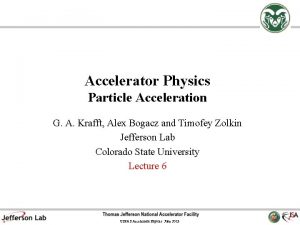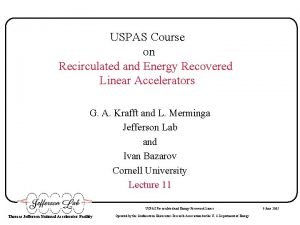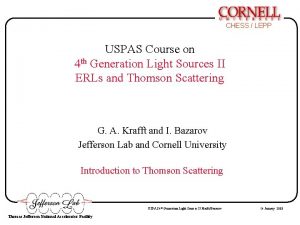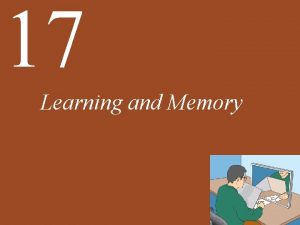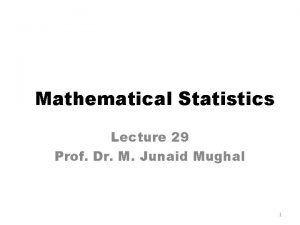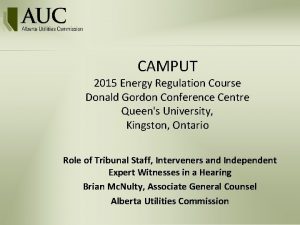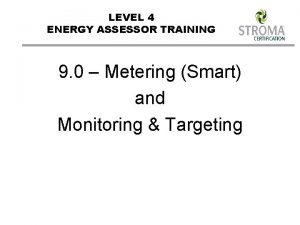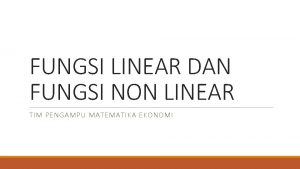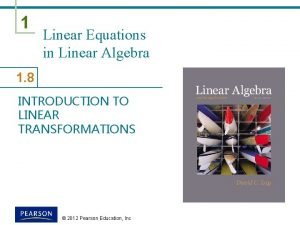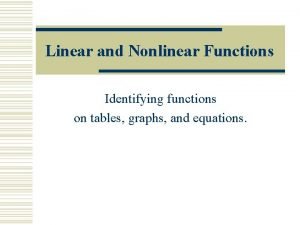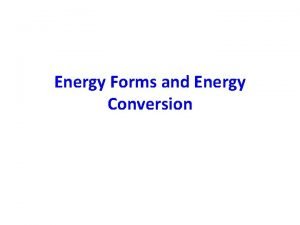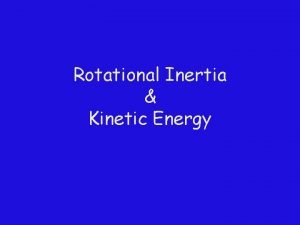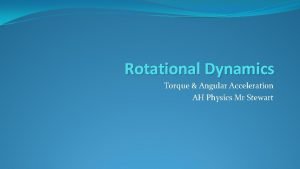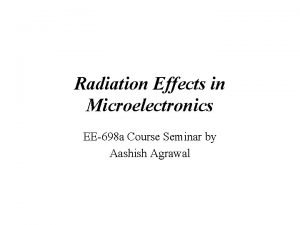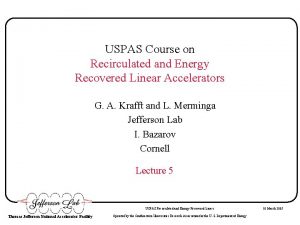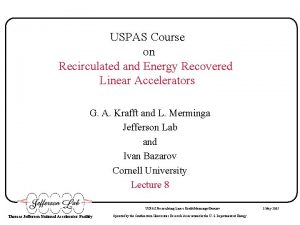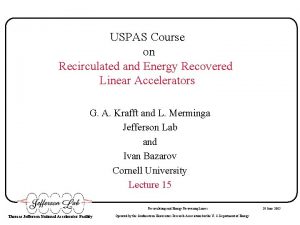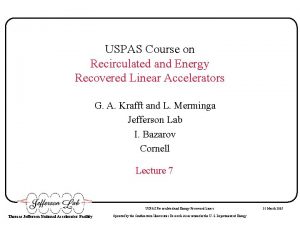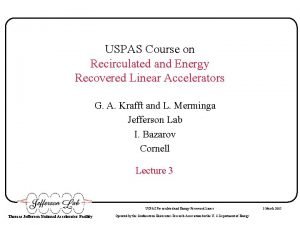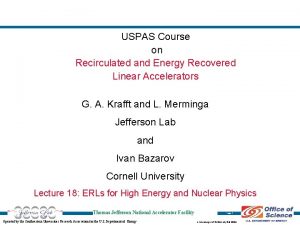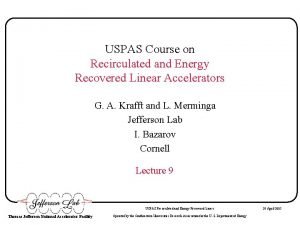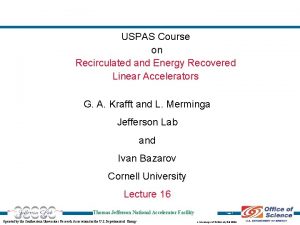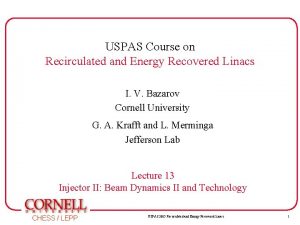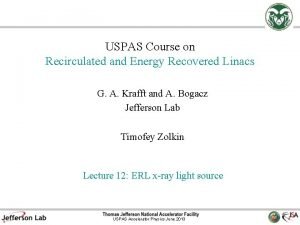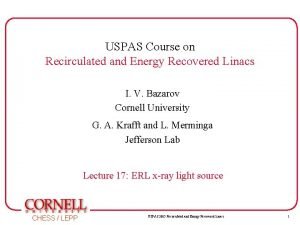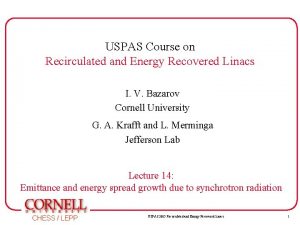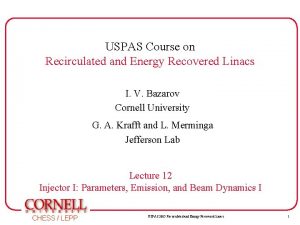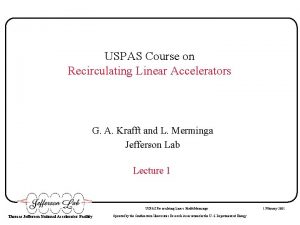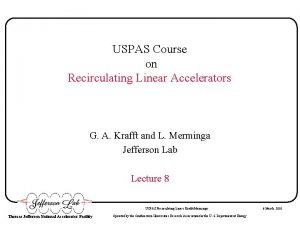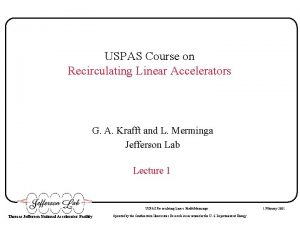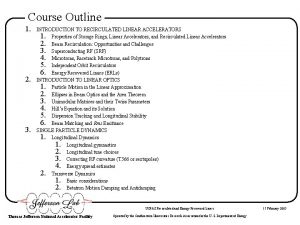USPAS Course on Recirculated and Energy Recovered Linear






















































- Slides: 54

USPAS Course on Recirculated and Energy Recovered Linear Accelerators G. A. Krafft and L. Merminga Jefferson Lab I. Bazarov Cornell Lecture 2 USPAS Recirculated and Energy Recovered Linacs Thomas Jefferson National Accelerator Facility Operated by the Southeastern Universities Research Association for the U. S. Department of Energy 24 February 2005

Outline § § § Homework Some More Definitions Need for of High Duty Factor Linacs Superconducting RF (SRF) • Historical Foundations of SRF • State of the Art in SRF in the 70’s, 80’s and 90’s • SRF Performance Limitations • Multipacting • Thermal Breakdown • Field Emission • State of the Art in SRF in 2000 • More Examples of Superconducting Recirculated and Energy Recovered Linacs Conclusions USPAS Recirculated and Energy Recovered Linacs Thomas Jefferson National Accelerator Facility Operated by the Southeastern Universities Research Association for the U. S. Department of Energy 24 February 2005

Homework Starting with the Lagrangian of a point particle with charge q and rest mass m in an electromagnetic field specified by the scaler potential Φ and the vector potential A show the Euler-Langrange equations reduce to the well-known relativistic Lorentz Force Equation where E and B are the electric field and magnetic field given by the usual relation between the fields and potentials and USPAS Recirculated and Energy Recovered Linacs Thomas Jefferson National Accelerator Facility Operated by the Southeastern Universities Research Association for the U. S. Department of Energy 24 February 2005

Homework From the relativistic Lorentz Force Equation in the previous problem, derive From the usual expression show Therefore, even at relativistic energies, magnetic fields cannot change the particle energy when radiation reaction is neglected. USPAS Recirculated and Energy Recovered Linacs Thomas Jefferson National Accelerator Facility Operated by the Southeastern Universities Research Association for the U. S. Department of Energy 24 February 2005

Energy Gain and Cavity Voltage For standing wave Maximum Energy Gain USPAS Recirculated and Energy Recovered Linacs Thomas Jefferson National Accelerator Facility Operated by the Southeastern Universities Research Association for the U. S. Department of Energy 24 February 2005

Definition: Quality Factor § Quality Factor Q 0 § § Q 0 gives the number of oscillations a resonator will go through before dissipating its stored energy. Q 0 is frequently written as: § G is the geometry constant and Rs is the surface resistance: § A convenient expression and a good fit for the BCS term is, § A well-prepared niobium surface can reach a residual resistance R 0 of 10 -20 n. Record values are near 1 n. USPAS Recirculated and Energy Recovered Linacs Thomas Jefferson National Accelerator Facility Operated by the Southeastern Universities Research Association for the U. S. Department of Energy 24 February 2005

Definition: Cavity Shunt Impedance § An important quantity used to characterize losses in a cavity, is the shunt impedance Ra (ohms per cavity) defined as § Ideally one wants Ra to be large for the accelerating mode so that dissipated power is minimized. Optimizing up particularly important for NC Cu cavities! Note that Ra/Q 0 is: • independent of the surface resistance • independent of cavity size, Ra/Q 0 ~ 100 /cell Will see later that the same Ra/Q 0 is used to determine the level of mode excitation by charges passing through the cavity. In NC cavities Ra/Q 0 is maximized by using small beam aperture • But Ra/Q 0 of HOMs tend to increase also beam interacts more strongly with the HOMs beam quality degrades bunch charge is limited. § § § USPAS Recirculated and Energy Recovered Linacs Thomas Jefferson National Accelerator Facility Operated by the Southeastern Universities Research Association for the U. S. Department of Energy 24 February 2005

Duty Factor – CW Operation: Definitions Duty Factor (DF) = USPAS Recirculated and Energy Recovered Linacs Thomas Jefferson National Accelerator Facility Operated by the Southeastern Universities Research Association for the U. S. Department of Energy 24 February 2005

Duty Factor – CW Operation: Definitions (cont’d) Trf = 1/ frf § § § CW RF: rf is continuously on CW Beam: Beam pulse is continuously on at the RF repetition rate or a subharmonic of it • Example 1. JLAB FEL: cw rf at 1497 MHz cw beam at 74. 85 MHz, the 20 th subharmonic of the rf wave • Example 2. CEBAF: cw rf at 1497 MHz cw beam at 499 MHz, the 3 rd subharmonic of the rf wave High Duty Factor: Duty Factor > 10% with beam pulse lengths of several msecs or more. USPAS Recirculated and Energy Recovered Linacs Thomas Jefferson National Accelerator Facility Operated by the Southeastern Universities Research Association for the U. S. Department of Energy 24 February 2005

The Need for High Duty Factor § § § High energy electrons have been used as nuclear probes: the electromagnetic interaction provides an ideal tool to measure the structure of nuclei. In 1977, Livingston Panel to examine: “The Role of Electron Accelerators in U. S. Medium Energy Nuclear Science. ” Livingston report: • Points out that almost all significant investigations to that date were “singlearm” experiments: only the scattered electron was detected. One reason: the event rate for coincidence experiments was limited by the best duty factor available from medium energy electron accelerators to only ~1%. • Recommends the next generation of electron accelerators to be capable of carrying out coincidence experiments: both the scattered electron and the associated ejected particle are detected. Conclusions of Livingston Panel are reinforced by sub-committee of the U. S. Nuclear Science Advisory Committee (Barnes et al. 1982). This committee recommends the construction of at least one cw electron accelerator with maximum energy of 4 Ge. V. USPAS Recirculated and Energy Recovered Linacs Thomas Jefferson National Accelerator Facility Operated by the Southeastern Universities Research Association for the U. S. Department of Energy 24 February 2005

The Need for High Duty Factor (cont’d) § § Coincidence experiments proceed faster using incident beams of high duty factor. The reason: • In a typical experiment, particles detected in one channel may be totally unrelated to particles detected in the opposite channel. need probability of observing “accidental coincidence” involving two unrelated particles to be small. • Probability of “accidental coincidence” I 2 peak • “True coincidence” rate Ipeak • For a given Iave or a given true event rate, Ipeak 1/DF the higher the DF, the lower the “accidental coincidence” rate compared to the true rate. USPAS Recirculated and Energy Recovered Linacs Thomas Jefferson National Accelerator Facility Operated by the Southeastern Universities Research Association for the U. S. Department of Energy 24 February 2005

SRF Recirculated Linacs for Nuclear Physics § The original motivation (Schwettman et al. , 1967) for building a superconducting electron linac at Stanford-HEPL for Nuclear Physics research was to provide: • continuous operation • high accelerating gradients • exceptional stability • energy resolution of order 10 -4 • beam currents up to 400 A § These characteristics continue to be desirable in modern electron accelerators for Nuclear Physics. It took longer than anticipated, but eventually all these objectives have all been met! USPAS Recirculated and Energy Recovered Linacs Thomas Jefferson National Accelerator Facility Operated by the Southeastern Universities Research Association for the U. S. Department of Energy 24 February 2005

SRF Recirculated Linacs for Nuclear Physics (cont’d) § For cw operation, power dissipated in the walls of a Cu structure is substantial. Not so for superconductors: • Power dissipated in cavity walls is: • § Microwave surface resistance of a superconductor is ~ 10 -5 lower than Cu Q 0 SC ~ 105 Q 0 Cu Option Superconducting Normal Conducting Q 0 2 x 109 2 x 104 R/Q (ohm/m) @ 500 MHz 330 900 Pdiss/L (Watt/m) @ Eacc=1 MV/m 1. 5 56000 !!! AC Power (k. W/m) 0. 54 112 Furthermore, the RF power to beam power efficiency is much higher in SC accelerators. USPAS Recirculated and Energy Recovered Linacs Thomas Jefferson National Accelerator Facility Operated by the Southeastern Universities Research Association for the U. S. Department of Energy 24 February 2005

SRF Recirculated Linacs for Nuclear Physics (cont’d) § For applications demanding high cw voltage, SC cavities have a clear advantage: • Recall: Pdiss ~ Eacc 2 • High fields ( >50 MV/m) can be produced in Cu cavities, but only for secs, because the rf power required becomes prohibitive and cooling becomes impossible! • Operating gradient in NC cavities, in cw mode, is limited to <1. 75 MV/m! USPAS Recirculated and Energy Recovered Linacs Thomas Jefferson National Accelerator Facility Operated by the Southeastern Universities Research Association for the U. S. Department of Energy 24 February 2005

SRF Recirculated Linacs for Nuclear Physics (cont’d) § Because Pdiss ~ 1/(R/Q), in NC cavities R/Q must be maximized by using a small beam aperture. § In SC cavities, one can afford to make the beam aperture much larger than NC cavities: • The resulting drop in R/Q for the accelerating mode is not a concern, because of the immensely larger Q 0. • And, advantages of bigger beam aperture are: a) It reduces short-range wakes reduces emittance growth along the linac b) It reduces the impedance of dangerous Higher Order Modes (HOMs) c) It reduces beam loss and beam-loss-induced radioactivity USPAS Recirculated and Energy Recovered Linacs Thomas Jefferson National Accelerator Facility Operated by the Southeastern Universities Research Association for the U. S. Department of Energy 24 February 2005

SRF Recirculated Linacs for Nuclear Physics (cont’d) § cw srf linacs make highly stable operation possible rf phase and amplitude can be controlled very precisely very low energy spread (~ 10 -5 at CEBAF) § In cw operation (made possible by srf cavities) high average current can be achieved with low peak current. interaction of beam with cavity and vacuum chamber is weak and small beam emittance can be preserved through the linac! USPAS Recirculated and Energy Recovered Linacs Thomas Jefferson National Accelerator Facility Operated by the Southeastern Universities Research Association for the U. S. Department of Energy 24 February 2005

SRF Recirculated Linacs as FEL Driver Accelerators § There are many candidate drivers for an FEL: dc electrostatic accelerators, storage rings, induction linacs, rf linacs § RF linacs are suitable for a variety of FELs because they • Offer high extraction efficiency higher PFEL • Offer good beam quality: low energy spread and low emittance, necessary for adequate overlap between laser and electron beam § SRF linacs are ideal as FEL drivers because: • excellent beam quality (as outlined earlier) • allow both high average power (in cw mode) and high efficiency! § In most high-power lasers, most of input energy is rejected as waste heat ability to remove heat sets power limitation (e. g. CO 2 lasers) In an FEL, the waste heat is in the form of electron beam power electron beam not converted to laser power is largely recoverable! § USPAS Recirculated and Energy Recovered Linacs Thomas Jefferson National Accelerator Facility Operated by the Southeastern Universities Research Association for the U. S. Department of Energy 24 February 2005

Historical Foundations of SRF § § HEPL at Stanford University was the pioneer laboratory in exploration of srf for accelerator applications. In 1965 they accelerated electrons in a lead-plated resonator In 1977 HEPL completed first Superconducting Accelerator (SCA) providing 50 MV in 27 m linac at 1. 3 GHz. (a) Single-cell HEPL Nb cavity, resonant frequency 1. 3 GHz (b) HEPL 7 -cell subsection USPAS Recirculated and Energy Recovered Linacs Thomas Jefferson National Accelerator Facility Operated by the Southeastern Universities Research Association for the U. S. Department of Energy 24 February 2005

Historical Foundations of SRF § § In 1977 the U. of Illinois completes construction of a microtron MUSL-2 with SCA sections that provided 13 MV. Both SCA and MUSL-2 aimed to provide cw high current (~ several 10 A) for precision Nuclear Physics research. Both operated at accelerating gradient of ~ 2 MV/m Multipacting limited the achievable gradient. (a) 7 -cell subsection of the HEPL structure, with 5 cells and 2 half end-cells (b) Multicell subsection of the HEPL SCA. Several subsections are joined together at the unexcited cells USPAS Recirculated and Energy Recovered Linacs Thomas Jefferson National Accelerator Facility Operated by the Southeastern Universities Research Association for the U. S. Department of Energy 24 February 2005

Historical Foundations of SRF USPAS Recirculated and Energy Recovered Linacs Thomas Jefferson National Accelerator Facility Operated by the Southeastern Universities Research Association for the U. S. Department of Energy 24 February 2005

Historical Foundations of SRF § § § At the same time Cornell wants to increase the energy of the 12 Ge. V CESR storage ring using high gradient srf structures. In aiming for high gradient, an important idea was to use higher rf frequency (2. 86 GHz). It would push the fields at which multipacting would occur to higher values! In 1975 the muffin-tin structure was developed. It accelerated electron beam of 100 A to 4 Ge. V. It operated at 4 MV/m, at Q 0~109. It was limited by thermal breakdown. USPAS Recirculated and Energy Recovered Linacs Thomas Jefferson National Accelerator Facility Operated by the Southeastern Universities Research Association for the U. S. Department of Energy 24 February 2005

Historical Foundations of SRF (cont’d) § § § In parallel srf activities are going on at the protons and heavy-ions front: In late 1960’s, KFK began exploring an srf linac for protons using helically loaded Nb cavities. Similar exploration started at ANL. Helical Nb resonator developed at ANL for a heavy-ion linac. § The structure exhibits poor mechanical stability: vibrations make control of rf phase difficult. USPAS Recirculated and Energy Recovered Linacs Thomas Jefferson National Accelerator Facility Operated by the Southeastern Universities Research Association for the U. S. Department of Energy 24 February 2005

Historical Foundations of SRF (cont’d) § § In 1974 Caltech develops a split-ring cavity geometry and successfully tackles the stability problem. It was fabricated from a thin film of lead electroplated on a Cu structure. It became the basis of the booster accelerator at SUNY. Typical operating gradient ~ 2. 5 MV/m. The three-gap split-loop, lead-on-copper resonator originated at Caltech. It accelerated charged particles with =0. 1, rf frequency is 150 MHz. USPAS Recirculated and Energy Recovered Linacs Thomas Jefferson National Accelerator Facility Operated by the Southeastern Universities Research Association for the U. S. Department of Energy 24 February 2005

Historical Foundations of SRF (cont’d) § In 1975 ANL starts development of Nb split-ring structure. It became the basis of ATLAS. Nb split-ring resonators used in ATLAS. The Nb components are hollow and filled with liquid He at 4. 2 K. Outer housing is made from Nb-Cu composite. § § § ATLAS was commissioned in 1978. Holds world record for longest running srf accelerator. Operating gradient for the split-ring Nb structures is ~ 2. 5 -3. 5 MV/m. USPAS Recirculated and Energy Recovered Linacs Thomas Jefferson National Accelerator Facility Operated by the Southeastern Universities Research Association for the U. S. Department of Energy 24 February 2005

State of the Art in SRF in the 70’s, 80’s and 90’s (a) Gradients limited by multipacting (b) Multipacting is solved but gradients are limited by thermal breakdown. (c) Thermal breakdown is alleviated by using high-purity, high-thermalconductivity Nb. Now gradients are predominantly limited by field emission, although thermal breakdown is also encountered. (Courtesy of H. Padamsee. ) USPAS Recirculated and Energy Recovered Linacs Thomas Jefferson National Accelerator Facility Operated by the Southeastern Universities Research Association for the U. S. Department of Energy 24 February 2005

State of the Art in SRF in the 70’s, 80’s and 90’s Total installed voltage capability with srf cavities for electron and heavy-ion accelerators. The growth for electron accelerators levels out between 1974 and 1984 because of problems with multipacting and thermal breakdown. (Courtesy of Jean Delayen) USPAS Recirculated and Energy Recovered Linacs Thomas Jefferson National Accelerator Facility Operated by the Southeastern Universities Research Association for the U. S. Department of Energy 24 February 2005

SRF Performance Limitations - Multipacting § Multipacting was a major performance limitation of srf cavities in the past. § Multipacting in rf structures is a resonant process. § A large number of electrons build up and multipacting, absorbing rf power so cavity fields can not increase by raising incident power. § Electrons collide with structure walls, leading to large temperature rise and, in srf cavities, thermal breakdown. § Multipacting can be avoided in =1 cavities by selecting proper cavity shape. USPAS Recirculated and Energy Recovered Linacs Thomas Jefferson National Accelerator Facility Operated by the Southeastern Universities Research Association for the U. S. Department of Energy 24 February 2005

Multipacting (cont’d) § § Onset of multipacting (MP) is usually recognized when the field level in the cavity remains fixed, as more rf power is supplied. In effect, Q 0 abruptly reduces at the MP threshold. Often a MP barrier can be overcome by processing. Barriers that can be processed are soft barriers, ones that persist are hard barriers. A processed soft barrier may reappear after the cavity is exposed to air: MP is strongly dependent on the condition of the first few monolayers of rf surface. (a) (b) Q 0 vs. Epk curves for srf cavity when one (a) or several (b) MP barriers are encountered. USPAS Recirculated and Energy Recovered Linacs Thomas Jefferson National Accelerator Facility Operated by the Southeastern Universities Research Association for the U. S. Department of Energy 24 February 2005

Multipacting (cont’d) Multipacting Mechanism § § § An electron is emitted from one of the structure’s surfaces. The emitted electron is accelerated by the rf fields and eventually impacts a wall again. Secondary electrons (SE’s) are produced. The number of SE’s depends on the surface characteristics and impact energy of the primary. The SE’s are accelerated, impact and produce another generation of electrons, etc… If the number of emitted electrons exceeds the number of impacting, then the electron current will increase exponentially. (Km): the secondary emission coefficient (SEC), material-dependent, function of impact energy. If (Km)>1 for all impact sites, MP will occur. Electron current will only be limited by available power or space charge effects. USPAS Recirculated and Energy Recovered Linacs Thomas Jefferson National Accelerator Facility Operated by the Southeastern Universities Research Association for the U. S. Department of Energy 24 February 2005

Multipacting (cont’d) A Common Multipacting Scenario § § Most frequent type of MP in =1 cavities: charges impact the cavity wall at, or near, the emission site itself. Emitted electrons are accelerated by E to the surface while the surface magnetic field force electrons in quasi-circular orbits, so they return to their point of origin. USPAS Recirculated and Energy Recovered Linacs Thomas Jefferson National Accelerator Facility Operated by the Southeastern Universities Research Association for the U. S. Department of Energy 24 February 2005

Multipacting (cont’d) Several solutions were explored: § Reducing the E field by making subtle alterations to the shape of the cavity. Was done on the HEPL cavities. Method was successful for the muffin-tin cavity. § Placing grooves in the surface where MP occurs. E is strongly attenuated at the bottom of the grooves, and secondaries remain trapped. § The most successful solution to MP problem was to make a spherical cavity. The magnetic field varies along the entire cavity wall , so there are no stable trajectories, as the electrons drift to the equator. At the equator, E vanishes, so secondaries do not gain any energy. § Elliptical is better than spherical from mechanical stability point of view. Elliptical cavity shapes are now universally adopted for =1 SRF cavities and MP is no longer a serious problem. USPAS Recirculated and Energy Recovered Linacs Thomas Jefferson National Accelerator Facility Operated by the Southeastern Universities Research Association for the U. S. Department of Energy 24 February 2005

Multipacting (cont’d) Electron trajectories in an elliptical cavity. The charges drift to the equator where MP is not possible. USPAS Recirculated and Energy Recovered Linacs Thomas Jefferson National Accelerator Facility Operated by the Southeastern Universities Research Association for the U. S. Department of Energy 24 February 2005

Multipacting (cont’d) Avoiding Multipacting § § Localize MP orbits by diagnostic tools. Track electrons and implement geometric modifications to shift barriers or to change resonant conditions. Use materials with low SEC. Cleanliness is imperative. Destabilize MP trajectories at the operating fields by applying a dc electric or magnetic field, such that it alters the MP trajectories. USPAS Recirculated and Energy Recovered Linacs Thomas Jefferson National Accelerator Facility Operated by the Southeastern Universities Research Association for the U. S. Department of Energy 24 February 2005

SRF Performance Limitations –Thermal Breakdown § Phenomena that limit the achievable magnetic field: thermal breakdown of superconductivity and field emission. § Thermal breakdown (or “quench”) originates at sub-mm-size regions, “defects, ” that have rf losses substantially higher than the surface resistance of an ideal superconductor. In dc case, supercurrents flow around the defects. At rf frequencies, the reactive part of the impedance causes the rf current to flow through the defect, producing ohmic heating. When T at the outside edge of the defect exceeds TC, the superconducting region surrounding the defect becomes normal -> power dissipation is increased. As NC region grows, power dissipation increases and results in thermal instability. § § USPAS Recirculated and Energy Recovered Linacs Thomas Jefferson National Accelerator Facility Operated by the Southeastern Universities Research Association for the U. S. Department of Energy 24 February 2005

Thermal Breakdown (cont’d) § Examples of defects: • 50 m Cu particle attached to Nb surface • Chemical or drying stain 440 m • 50 m crystal containing S, Ca, Cl, K § There are many opportunities for such defects to enter an srf cavity during the various stages of production and preparation. § Statistically, number of defects increases with cavity area larger cavities break down at lower fields. USPAS Recirculated and Energy Recovered Linacs Thomas Jefferson National Accelerator Facility Operated by the Southeastern Universities Research Association for the U. S. Department of Energy 24 February 2005

§ Thermal Breakdown (cont’d) Solutions to thermal breakdown a) Guided Repair One or two gross defects can be located by thermometry and removed by mechanical grinding. Example: 350 MHz single-cell Nb cavity Eacc was increased from 5 MV/m ->10 MV/m. Not easy for smaller defects. b) Raising Thermal Conductivity of Niobium Hmax If raise , Hmax will increase. Defects will be able to tolerate more power before driving neighboring superconductor into normal state. Approximately, = 0. 25 (W/m-K) x RRR Thermal conductivity of Nb with different RRR values. USPAS Recirculated and Energy Recovered Linacs Thomas Jefferson National Accelerator Facility Operated by the Southeastern Universities Research Association for the U. S. Department of Energy 24 February 2005

Thermal Breakdown (cont’d) c) Thin Films of Niobium on Copper § § Use m-thick film of Nb on a thermally stabilizing copper substrate. Thermal conductivity of Cu is much greater than of Nb. Thermal conductivity of high-purity Cu samples compared to low-temperature thermal conductivity of Nb samples of various RRR. Note that at RRR~1000, thermal conductivity of Nb begins to approach that of Cu. USPAS Recirculated and Energy Recovered Linacs Thomas Jefferson National Accelerator Facility Operated by the Southeastern Universities Research Association for the U. S. Department of Energy 24 February 2005

State of the Art in SRF in 2000 (a) (b) (a) Average gradient in all 9 -cell TESLA cavities measured in vertical tests during the past 5 years. (b) Average gradient as measured in vertical tests, of the TESLA 9 -cell cavities assembled into accelerator modules. USPAS Recirculated and Energy Recovered Linacs Thomas Jefferson National Accelerator Facility Operated by the Southeastern Universities Research Association for the U. S. Department of Energy 24 February 2005

State of the Art in SRF in 2000 Total installed voltage capability with srf cavities for electron and heavy-ion accelerators. USPAS Recirculated and Energy Recovered Linacs Thomas Jefferson National Accelerator Facility Operated by the Southeastern Universities Research Association for the U. S. Department of Energy 24 February 2005

Layout of S-DALINAC (Darmstadt) USPAS Recirculated and Energy Recovered Linacs Thomas Jefferson National Accelerator Facility Operated by the Southeastern Universities Research Association for the U. S. Department of Energy 24 February 2005

S-DALINAC USPAS Recirculated and Energy Recovered Linacs Thomas Jefferson National Accelerator Facility Operated by the Southeastern Universities Research Association for the U. S. Department of Energy 24 February 2005

S-DALINAC Beam Parameters USPAS Recirculated and Energy Recovered Linacs Thomas Jefferson National Accelerator Facility Operated by the Southeastern Universities Research Association for the U. S. Department of Energy 24 February 2005

Superconducting 20 -Cell Cavity Material: Niobium (RRR=280) Frequency: 3 GHz Temperature: 2 K Accelerating Field: 5 MV/m Q 0/QL: 3· 109 / 3· 107 Df/Dl: 500 Hz/µm USPAS Recirculated and Energy Recovered Linacs Thomas Jefferson National Accelerator Facility Operated by the Southeastern Universities Research Association for the U. S. Department of Energy 24 February 2005

§ § The CEBAF at Jefferson Lab Most radical innovations (had not been done before on the scale of CEBAF): • choice of Superconducting Radio Frequency (SRF) technology • use of multipass beam recirculation Until LEP II came into operation, CEBAF was the world’s largest implementation of SRF technology. USPAS Recirculated and Energy Recovered Linacs Thomas Jefferson National Accelerator Facility Operated by the Southeastern Universities Research Association for the U. S. Department of Energy 24 February 2005

CEBAF Accelerator Layout* *C. W. Leemann, D. R. Douglas, G. A. Krafft, “The Continuous Electron Beam Accelerator Facility: CEBAF at the Jefferson Laboratory”, Annual Reviews of Nuclear and Particle Science, 51, 413 -50 (2001) has a long reference list on the CEBAF accelerator. Many references on Energy Recovered Linacs may be found in a recent ICFA Beam Dynamics Newsletter, #26, Dec. 2001: http: //icfausa/archive/newsletter/icfa_bd_nl_26. pdf USPAS Recirculated and Energy Recovered Linacs Thomas Jefferson National Accelerator Facility Operated by the Southeastern Universities Research Association for the U. S. Department of Energy 24 February 2005

CEBAF Beam Parameters Beam energy 6 Ge. V Beam current A 100 μA, B 10 -200 n. A, C 100 μA Normalized rms emittance Repetition rate 1 mm mrad 500 MHz/Hall Charge per bunch < 0. 2 p. C Extracted energy spread < 10 Beam sizes (transverse) Beam size (longitudinal) Beam angle spread < 100 microns <100 microns (330 fsec) < 0. 1/γ USPAS Recirculated and Energy Recovered Linacs Thomas Jefferson National Accelerator Facility Operated by the Southeastern Universities Research Association for the U. S. Department of Energy 24 February 2005

Energy Recovered Linacs § The concept of energy recovery first appears in literature by Maury Tigner, as a suggestion for alternate HEP colliders* § There have been several energy recovery experiments to date, the first one in a superconducting linac at the Stanford SCA/FEL** § Same-cell energy recovery with cw beam current up to 10 m. A and energy up to 150 Me. V has been demonstrated at the Jefferson Lab 10 k. W FEL. Energy recovery is used routinely for the operation of the FEL as a user facility * Maury Tigner, Nuovo Cimento 37 (1965) ** T. I. Smith, et al. , “Development of the SCA/FEL for use in Biomedical and Materials Science Experiments, ” NIMA 259 (1987) USPAS Recirculated and Energy Recovered Linacs Thomas Jefferson National Accelerator Facility Operated by the Southeastern Universities Research Association for the U. S. Department of Energy 24 February 2005

The SCA/FEL Energy Recovery Experiment § § Same-cell energy recovery was first demonstrated in an SRF linac at the SCA/FEL in July 1986 Beam was injected at 5 Me. V into a ~50 Me. V linac The first recirculation system (SCR, 1982) was unsuccessful in obtaining the peak current required for lasing and was replaced by a doubly achromatic single-turn recirculation line. All energy was recovered. FEL was not in place. T. I. Smith, et al. , NIM A 259, 1 (1987) USPAS Recirculated and Energy Recovered Linacs Thomas Jefferson National Accelerator Facility Operated by the Southeastern Universities Research Association for the U. S. Department of Energy 24 February 2005

The CEBAF Injector Energy Recovery Experiment N. R. Sereno, “Experimental Studies of Multipass Beam Breakup and Energy Recovery using the CEBAF Injector Linac, ” Ph. D. Thesis, University of Illinois (1994) USPAS Recirculated and Energy Recovered Linacs Thomas Jefferson National Accelerator Facility Operated by the Southeastern Universities Research Association for the U. S. Department of Energy 24 February 2005

The Jefferson Lab IR FEL Wiggler assembly Neil, G. R. , et. al, Physical Review Letters, 84, 622 (2000) USPAS Recirculated and Energy Recovered Linacs Thomas Jefferson National Accelerator Facility Operated by the Southeastern Universities Research Association for the U. S. Department of Energy 24 February 2005

FEL Accelerator Parameters Parameter Designed Measured Kinetic Energy 48 Me. V 48. 0 Me. V Average current 5 m. A 4. 8 m. A Bunch charge 60 p. C Up to 135 p. C Bunch length (rms) <1 ps 0. 4 0. 1 ps Peak current 22 A Up to 60 A Trans. Emittance (rms) <8. 7 mmmr 7. 5 1. 5 mmmr Long. Emittance (rms) 33 ke. Vdeg 26 7 ke. Vdeg Pulse repetition frequency (PRF) 18. 7 MHz, x 2 18. 7 MHz, x 0. 25, x 0. 5, x 2, and x 4 USPAS Recirculated and Energy Recovered Linacs Thomas Jefferson National Accelerator Facility Operated by the Southeastern Universities Research Association for the U. S. Department of Energy 24 February 2005

IR FEL Upgrade USPAS Recirculated and Energy Recovered Linacs Thomas Jefferson National Accelerator Facility Operated by the Southeastern Universities Research Association for the U. S. Department of Energy 24 February 2005

IR FEL 10 k. W Upgrade Parameters Parameter Design Value Kinetic Energy 160 Me. V Average Current 10 m. A Bunch Charge 135 p. C Bunch Length <300 fsec 10 mm mrad Transverse Emittance Longitudinal Emittance Repetition Rate 30 ke. V deg 75 MHz USPAS Recirculated and Energy Recovered Linacs Thomas Jefferson National Accelerator Facility Operated by the Southeastern Universities Research Association for the U. S. Department of Energy 24 February 2005

Conclusions § Recirculated linacs used for Nuclear Physics research or as driver accelerators for FELs and synchrotron radiation sources benefit from cw or high duty factor operation. § CW or high duty factor operation at higher gradients/high currents practically necessitates the use of superconducting cavities. § RF superconductivity applied to particle accelerators has made tremendous progress in the last ~ 30 years. § Major srf limitations due to multipacting, thermal breakdown, and field emission have been understood and successfully combated to a large extent. § CW operation at higher gradients (> 20 MV/m) and higher average currents yet (~100 m. A), is the new challenge rf superconductivity is facing! USPAS Recirculated and Energy Recovered Linacs Thomas Jefferson National Accelerator Facility Operated by the Southeastern Universities Research Association for the U. S. Department of Energy 24 February 2005
 Uspas sport
Uspas sport Uspas
Uspas Uspas
Uspas Energy energy transfer and general energy analysis
Energy energy transfer and general energy analysis Energy energy transfer and general energy analysis
Energy energy transfer and general energy analysis Course title and course number
Course title and course number Who gets affected directly or indirectly due to accident
Who gets affected directly or indirectly due to accident Recovered memory 17 location
Recovered memory 17 location Short working can be recouped out of *
Short working can be recouped out of * Dr junaid mughal
Dr junaid mughal Cut brick lengthwise
Cut brick lengthwise Course interne moyenne externe
Course interne moyenne externe Linear regression vs multiple regression
Linear regression vs multiple regression Types of linear text
Types of linear text Linear plot definition
Linear plot definition Difference between linear pipeline and non linear pipeline
Difference between linear pipeline and non linear pipeline Linear and non linear multimedia
Linear and non linear multimedia Linear impulse equation
Linear impulse equation Persamaan linier simultan adalah
Persamaan linier simultan adalah Left linear grammar example
Left linear grammar example Difference between linear and nonlinear equations
Difference between linear and nonlinear equations How to solve non linear simultaneous equations
How to solve non linear simultaneous equations Camput energy regulation course
Camput energy regulation course Energy assessor training
Energy assessor training Contoh persamaan non linear
Contoh persamaan non linear Contoh soal metode numerik
Contoh soal metode numerik Fungsi linear dan non linear matematika ekonomi
Fungsi linear dan non linear matematika ekonomi Sebutkan dan jelaskan contoh fungsi non linier
Sebutkan dan jelaskan contoh fungsi non linier Linearly dependent vectors
Linearly dependent vectors Linear algebra linear transformation
Linear algebra linear transformation Berapa lereng dan penggal garis pada sumbu y
Berapa lereng dan penggal garis pada sumbu y Linear and nonlinear tables
Linear and nonlinear tables Linear vs nonlinear
Linear vs nonlinear Linear and nonlinear editing
Linear and nonlinear editing Right linear grammar
Right linear grammar Narrador onisciente
Narrador onisciente What is the definition of chemical potential energy
What is the definition of chemical potential energy Primary energy and secondary energy
Primary energy and secondary energy Disadvantages of conventional energy
Disadvantages of conventional energy Helmholtz free energy and gibbs free energy
Helmholtz free energy and gibbs free energy Renewable energy and energy efficiency partnership
Renewable energy and energy efficiency partnership Definition of kinetic energy
Definition of kinetic energy Kinetic energy of spring
Kinetic energy of spring Formula of potential energy
Formula of potential energy The change in mechanical energy
The change in mechanical energy Eroei
Eroei Moment of inertia hoop vs disk
Moment of inertia hoop vs disk Linear kinetic energy
Linear kinetic energy Kinetic energy in terms of momentum
Kinetic energy in terms of momentum Linear energy transfer
Linear energy transfer Linear energy
Linear energy Kinetic energy of a spring
Kinetic energy of a spring Gibbs free energy non standard conditions
Gibbs free energy non standard conditions Q chemistry
Q chemistry Energy times distance
Energy times distance
